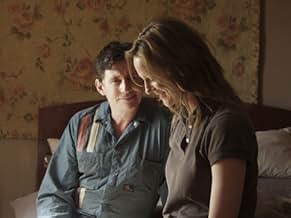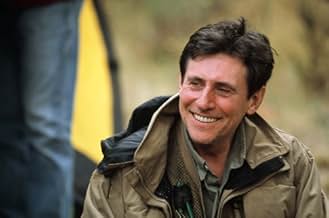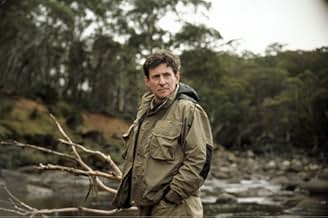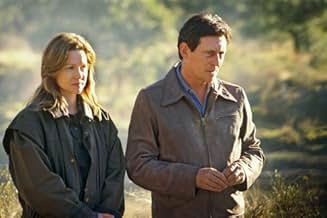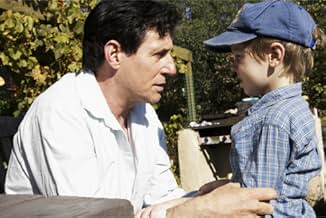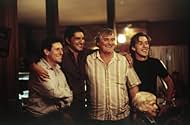IMDb RATING
6.3/10
7.1K
YOUR RATING
After four men on a fishing trip discover a dead body in the water, they choose to delay reporting it and continue fishing.After four men on a fishing trip discover a dead body in the water, they choose to delay reporting it and continue fishing.After four men on a fishing trip discover a dead body in the water, they choose to delay reporting it and continue fishing.
- Awards
- 11 wins & 21 nominations total
- Director
- Writers
- All cast & crew
- Production, box office & more at IMDbPro
Storyline
Did you know
- TriviaGabriel Byrne accidentally stepped on a Brown Snake, one of the world's deadliest, while walking through the bush one day on the set. If he'd stepped on the other end he'd have been bitten. Gabriel Byrne told the director Ray Lawrence that he was almost killed, to which Lawrence replied: "No worries mate. You would have had 24 hours..."
- GoofsJust before the fishing trip, Stewart dyes his graying hair black. At the river, the gray reappears, but his hair inexplicably turns jet-black again upon his return.
- ConnectionsFeatured in At the Movies: Episode #3.22 (2006)
Featured review
This is an intriguing, evocative and multilayered film superbly acted and wonderfully filmed (mostly in single takes, it seems). It is also rather slow and meandering, and problematic. The basic plot could be set almost anywhere failure of personal relationships in the context of a failure of civic duty, but Ray Lawrence has chosen to adapt Raymond Carver's short story of the fishermen who took their time over reporting finding a woman's body to a highly specific place, Jindabyne, NSW, and to include the vexed question of black/white relationships in Australia.
As is pointed out in one of those awful cheery 1960s documentary being shown to the kids in the local primary school, the present day Jindabyne is a "second chance" sort of place, the old town having disappeared under the waters of Lake Jindabyne during the creation of the Snowy Mountains Hydro Scheme, though at very low water levels the old church steeple is said to poke out of the water. Unfortunately, as we are shown in the opening sequence there is still evil in the new town in the shape of the local electrician (Chris Heywood, very nasty), who likes to hunt and kill young women. It is his victim's body the four fishing buddies, Stewart, Carl, Rocco and Billy, find in the stream, tie to a log, fish for a day, and then the next morning decide to raise the alarm.
When it becomes public that the four delayed reporting their find to go fishing (why didn't they lie about when they found the body?) there is a predictable uproar. The dead woman was aboriginal and the local aboriginals are particularly upset since they see this as symptomatic of whitey attitudes). Rocco's aboriginal girlfriend is not impressed. But the greatest emotional impact falls on Stewart (an Irishman) and his American wife Claire whose relationship is already rocky.
At one point I thought Claire was going to crack the case, but instead we get a literally hazy scene where some kind of reconciliation between black and white is attempted. After seeing the superb "Ten Canoes" recently I found the whole aboriginal storyline contrived. What I did think was very powerful and affecting was the portrayal of a damaged marriage. Gabriel Byrne does not put a foot wrong as Stewart, an ordinary bloke resigned to what little emotional comfort he can get from his family, and Laura Linney gives great depth to her role as his wife Claire, a woman for whom motherhood is a daunting task.
The rest of the cast are fine. Debra-Lee Furness as Carl's wife Jude makes a dislikeable character understandable, John Howard as Carl puts in a solid performance and there are two good performances from child actors Eva Lazzaro as Jude's disturbed granddaughter, and Sean Rees-Wemyss as Stewart and Claire's son Tom.
Ray Lawrence clearly did not set out to create a crime story but he certainly shows that crime can have some unexpected collateral damage. He also has contributed to the "Cinema of Unease", a phrase Sam Neill once used to describe New Zealand cinema, by setting a story about personal and public guilt in such a glorious setting.
As is pointed out in one of those awful cheery 1960s documentary being shown to the kids in the local primary school, the present day Jindabyne is a "second chance" sort of place, the old town having disappeared under the waters of Lake Jindabyne during the creation of the Snowy Mountains Hydro Scheme, though at very low water levels the old church steeple is said to poke out of the water. Unfortunately, as we are shown in the opening sequence there is still evil in the new town in the shape of the local electrician (Chris Heywood, very nasty), who likes to hunt and kill young women. It is his victim's body the four fishing buddies, Stewart, Carl, Rocco and Billy, find in the stream, tie to a log, fish for a day, and then the next morning decide to raise the alarm.
When it becomes public that the four delayed reporting their find to go fishing (why didn't they lie about when they found the body?) there is a predictable uproar. The dead woman was aboriginal and the local aboriginals are particularly upset since they see this as symptomatic of whitey attitudes). Rocco's aboriginal girlfriend is not impressed. But the greatest emotional impact falls on Stewart (an Irishman) and his American wife Claire whose relationship is already rocky.
At one point I thought Claire was going to crack the case, but instead we get a literally hazy scene where some kind of reconciliation between black and white is attempted. After seeing the superb "Ten Canoes" recently I found the whole aboriginal storyline contrived. What I did think was very powerful and affecting was the portrayal of a damaged marriage. Gabriel Byrne does not put a foot wrong as Stewart, an ordinary bloke resigned to what little emotional comfort he can get from his family, and Laura Linney gives great depth to her role as his wife Claire, a woman for whom motherhood is a daunting task.
The rest of the cast are fine. Debra-Lee Furness as Carl's wife Jude makes a dislikeable character understandable, John Howard as Carl puts in a solid performance and there are two good performances from child actors Eva Lazzaro as Jude's disturbed granddaughter, and Sean Rees-Wemyss as Stewart and Claire's son Tom.
Ray Lawrence clearly did not set out to create a crime story but he certainly shows that crime can have some unexpected collateral damage. He also has contributed to the "Cinema of Unease", a phrase Sam Neill once used to describe New Zealand cinema, by setting a story about personal and public guilt in such a glorious setting.
- How long is Jindabyne?Powered by Alexa
Details
- Release date
- Country of origin
- Official site
- Languages
- Also known as
- Джиндабайн
- Filming locations
- Production companies
- See more company credits at IMDbPro
Box office
- Budget
- A$15,000,000 (estimated)
- Gross US & Canada
- $400,438
- Opening weekend US & Canada
- $28,298
- Apr 29, 2007
- Gross worldwide
- $6,044,112
- Runtime2 hours 3 minutes
- Color
- Sound mix
- Aspect ratio
- 2.35 : 1
Contribute to this page
Suggest an edit or add missing content



